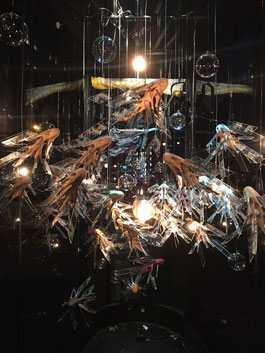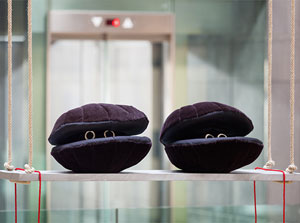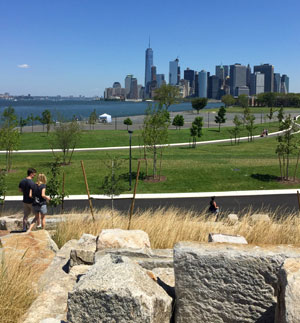All Washed Up
John Haberin New York City
Garret Kane, Cosima von Bonin, and Aki Sasamoto
The 2016 Governors Island Art Fair
When artists bring nature into the gallery, is it alive? If art after Modernism can no longer claim a window onto the world, it can still offer one heck of a walk-in closet.
Quite apart from landscape painting, artists have built model cities and artificial trees. They have brought earthworks indoors. Now art goes fishing. Garret Kane dives into the ocean, only to find artificial life passing overhead.  Cosima von Bonin and Aki Sasamoto head for the beach, with washing machines to supply the surf. And the Governors Island Art Fair tunnels deep into old fortifications only to find how much has washed up from the island's past, its new landscaping, and its shore.
Cosima von Bonin and Aki Sasamoto head for the beach, with washing machines to supply the surf. And the Governors Island Art Fair tunnels deep into old fortifications only to find how much has washed up from the island's past, its new landscaping, and its shore.
Coming up for air
For once, the Prow Art Space lives up to its name. Passing the Flatiron Building after dark, you can see a strange glow from within—along with strange creatures mostly overhead and on the other side of the glass. You can imagine not you but the building in motion, like a ship in the night. You can imagine yourself, too, in the ocean depths as the creatures swim past. You may not mind that you cannot quite put a name on them. You may not even wish to come up for air.
Garret Kane arranges Mimicri in a tight school, and I owe its identity as fish to him. While the creatures hang suspended within the space, one can still see the ship cutting through their more organic motion. Feel free, though, to imagine them as something else. I first saw them in daylight as a flock of birds, already coming up for air. Up close, they could pass for animal heads or merely antlers, in wood polished with oil. Their forked outlines add to the illusion of motion, as does the variation in wood tone from pale to dark red.
To add to the ambiguity, they are not altogether alive—quite apart from their machine manufacture after a single carving. Not that Kane (also known as Garret Dafferner) is bending over backward to make a postmodern statement against the originality of the avant-garde. He is just going about his craft, but he does have in mind a challenge to the boundaries separating technology, art, and life. The creatures also bear shards of glass screen-printed with what look like circuit boards in white, and he pictures them as a network. Maybe it helps that a Sprint store is the floor's primary tenant and controls the lease, or maybe not. This network does not require new media.
At what point does a network become alive, from a single circuit to the interlocking systems of the Web? What about an ant colony or the neural connections of the brain? At what point, in turn, do organisms lose their uniqueness and autonomy? As Kane puts it, "we recreate nature in our own image." To add to the riddle, he shares the space with quite another network, Cheddar TV, which uses it to conduct interviews. Its needs account for the relative darkness even during the day, but it still leaves space for the illusion.
Reading too much into art and science can grow awfully pretentious, even when a show directly targets "Twisted Data." So does talk about networking here. Still, like circuitry and landscape for James Hoff, the display takes on a life of its own. Over the course of the run, it may grow to fill more of the space and evolve, although not by natural selection. The LED lights, too, are part of the show. Enclosed in glass, sometimes as larger spheres, they could stand for a century-old lab.
The work also foregrounds questions about the space. Sprint has declared it dead to art before and may yet again. Even now, Kane has access to only about half of it—unlike Serena Gidwani Buschi, Gwyneth Leech, Christina Lihan, and Xin Song before him. Still, he is not an obsessive collector, like something out of "The Keeper" at the New Museum, and the work gains from immersion in a greater darkness. For now, the various tenants are getting along—and their co-existence may even spur further ideas for installations and interviews. Cross your fingers, and take a deep breath.
Something fishy
Ooh, where do you get that? My kids would love one of those! Do not be embarrassed if something like that comes to mind at SculptureCenter, where three inflatable fish frolic together. They might be sharks or baby whales, but marine biology is beside the point. They are simply large, gray, and insufferably cute, and no one is going to let the air out any time soon, least of all Cosima von Bonin. A first-time reviewer for The Times observed that the German artist "owes as much to Finding Nemo" as to Edouard Manet, James McNeill Whistler, and "other artists who turned to the sea"—and, the sea gods help us, he meant it as a compliment.
 Is something fishy here? Inside lies an entire beach resort, give or take sand, water, and vacationers. A stuffed crab or lobster has taken over the lifeguard's chair. A cuddly and colorful octopus has draped itself over a platform somewhere between a beach towel and a boxing ring. Other shellfish occupy the swings, with padded interiors and goo-goo-googly eyes. Changing rooms and food stalls stand boarded-up and empty. A woman's undergarments preside over the whole, like a banner ad for nothing.
Is something fishy here? Inside lies an entire beach resort, give or take sand, water, and vacationers. A stuffed crab or lobster has taken over the lifeguard's chair. A cuddly and colorful octopus has draped itself over a platform somewhere between a beach towel and a boxing ring. Other shellfish occupy the swings, with padded interiors and goo-goo-googly eyes. Changing rooms and food stalls stand boarded-up and empty. A woman's undergarments preside over the whole, like a banner ad for nothing.
If nothing else, von Bonin and, downstairs, Aki Sasamoto share a jaundiced view of humanity. For one it is incorrigibly lazy, for the other obsessive to a fault. If there they disagree, no matter: people are on their way out, to be replaced by sea creatures or insects, depending on which artist you care to trust. Either way, our successors are too childish by half— but so, it appears, are we. Unfortunately, so is the art.
Sasamoto might be taking on that banner in the pebbled sculpture garden, with a clothes line. She may also have it in for those fish, with pots that could quickly turn them into dinner. Mostly, though, the Japanese artist is just cleaning house—because, she suggests, that is most of what people are doing as well. She views civilization as obsessed with laundry, with the washing machines and driers running full time, as "Delicate Cycle." She views it as self-obsessed as well, with brand-name shoe boxes lining the center's basement tunnels, along with those washers and driers. A pile of meticulously white sheets, backed by a ghostly green light, are its only monument.
A video has Sasamoto in the laundry room herself, alternating with the dullest TV science ever, about those dung beetles. Apparently, they serve as a model for us all, carrying their house and dung for food on their back. Forgive me if I cannot be bothered to fact check this for the latest poop, since this, too, is not about the fate of the planet. It is not even all that site specific, despite its choice location. It is about an artist who appeared in the 2010 Whitney Biennial and, the same year, in Greater New York at MoMA PS. It is also about an artist finally letting on what really matters.
Sasamoto gains from her obsession, which extends to several "paintings," of kitchen tools on monochrome canvas. And von Bonin gains from bringing together work since 2000, which becomes a more convincing environment to itself. Still, their sadness and whimsy amount to two sides of the same thing, sentimentality. Is anything at stake, beyond where to go for balloons and stuffed animals? von Bonin's title makes it sound as if other species shared responsibility with pollution and climate change for their own extinction—or maybe for her art: "Who's Exploiting Who in the Deep Sea?" Who cares?
So short a history
Castle Williams has quite a history—to judge by the 2016 Governors Island Art Fair, one better measured in geologic time than in New York stories. Volcanic stones seem to have tumbled into its courtyard, thanks to José Carlos Casado, his crumpled metal sheets saturated in black and color. Water from some subterranean cave still rains down on a larger black construction upstairs, thanks to Charlotte Becket. Humanity enters, too, where a projection creates a ring of fire, from Chaney Trotter, flanked by dirt, debris, and cots that might once have held the island's sailors and soldiers. A beached dolphin, whale, or shark by Charlie Cunningham might have drifted in from New York harbor, but wearing sneakers. For one last step between past and present, a spiral sculpture by Mark Lorah bridges geology, biology, and sculpture by Tony Smith, but in white cardboard.
The Governors Island Art Fair (as of 2019, Portal GI) often seems stuck just slightly in the past. It centers on the former officer's housing of Colonels Row, between stairwells and peeling paint. Like most artist collectives, it also sticks mostly to the tried and true, one artist to a room. Painting can leave as haunting a presence as women by E. Thurston Bellmer, and site-specific work can mimic or challenge its surroundings, like a replica of the underlying kitchen on canvas by Cody Brgant. Together, they present what another artist, Umberto Kamperveen, calls a specimen sanctuary. Still, political and conceptual touches seem beside the point, along with the island's actual history and electrifying painting.
That helps explain why this year's Governors Island Art Fair gains by stepping out. That begins with small steps. Another of Cunningham's dead fish tumbles off a front porch, titled Nude Descending a Staircase after Marcel Duchamp. The steps continue onto the front lawn, where Bernard Klevickas gives metal the forward thrust of an enormous red kite.  Rusted metal from Roderigo Nava stands on spreading sheets like clothespins for Claes Oldenburg. Larger strides, though, carry the work to Castle Williams and Fort Jay.
Rusted metal from Roderigo Nava stands on spreading sheets like clothespins for Claes Oldenburg. Larger strides, though, carry the work to Castle Williams and Fort Jay.
Who knows what else might wash up, all the way to the castle's second floor? Alisha Wessler covers the floor with lotus twigs and Emily Chatton with blue swirls. On the way toward Fort Jay, an automobile pileup seems to have produced not an abstraction, as for John Chamberlain, but a makeshift helicopter, with an assist from Aleksander Razin. It may come as close to a comment on the former military outpost as anything in the show. That lack of specificity can feel like a major lost opportunity. It also has the irony of looking back, just when Governors Island is leaping ahead.
Landscaping has transformed the island's south half into a play land, but with little equipment beyond artificial hills. They give places to climb and outlooks onto Lower Manhattan, Brooklyn, and the Statue of Liberty, which has never looked closer. They nestle a sculpture by Rachel Whiteread, playing fields, and picnic grounds, which people seem more inclined to use for a rest and the view. They even offer sliding ponds back down. Not that the grounds were half bad before years of being fenced off, and one can still bike around the edges. Still, they invite one to imagine New York itself as a shining city on a hill.
As for the fair, it feels arbitrary to single out any of the roughly one hundred contributors—or to dismiss them. I feel guilty already. (Additional artists occupy the wood-framed houses of Nolan Park on the island's northeast end, as usual, including Sculptor's Guild.) If they cannot surpass their setting, at least this year they are addressing it. Several video loops dissolve the tunneled ceilings of the fort's magazine, while recovering them as a user experience. There, too, as with Wiley Aker, the fair seems at its best suspended between past and present.

Garret Kane ran in the Prow Art Space of the Flatiron Building through December 1, 2016, curated by Cheryl McGinnis. The Governors Island Art Fair ran on weekends through September 25, and the new landscaping opened July 19. Cosima von Bonin and Aki Sasamoto ran at SculptureCenter through January 2, 2017.




